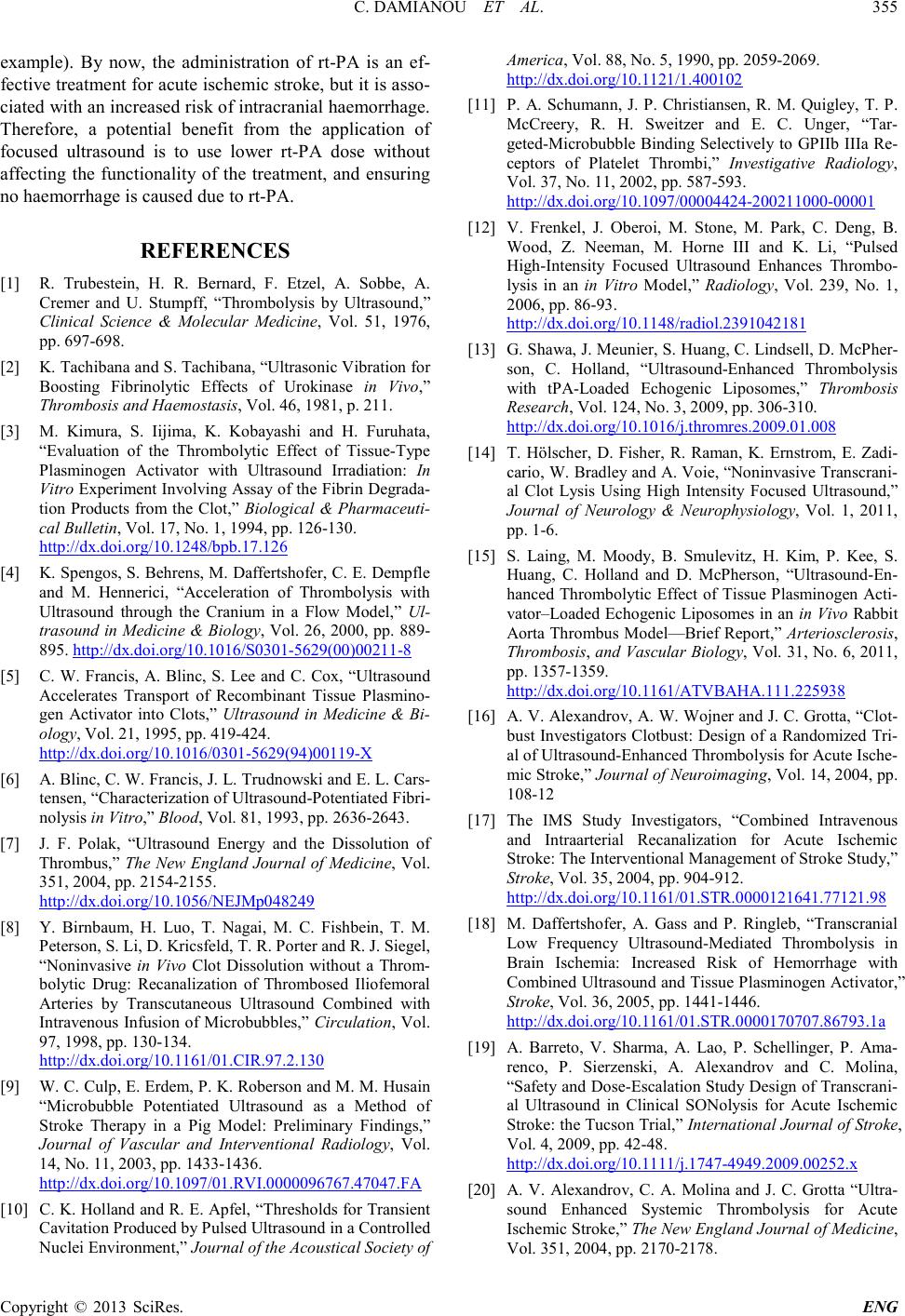
C. DAMIANOU ET AL.
Copyright © 2013 SciRes. ENG
example). By now, the administration of rt-PA is an ef-
fective treatment for acute ischemic stroke, but it i s as so-
ciated with an increased risk of intracranial haemorrhage.
Therefore, a potential benefit from the application of
focused ultrasound is to use lower rt-PA dose without
affecting the functionality of the treatment, and ensuring
no haemorrhage is cause d due to rt-PA.
REFERENCES
[1] R. Trubestein, H. R. Bernard, F. Etzel, A. Sobbe, A.
Cremer and U. Stumpff, “Thrombolysis by Ultrasound,”
Clinical Science & Molecular Medicine, Vol. 51, 1976,
pp. 697-698.
[2] K. Tachibana and S. Tachi bana, “Ultrasonic Vibration for
Boosting Fibrinolytic Effects of Urokinase in Vivo,”
Thrombo si s an d Haemostasis, Vol. 46, 1981, p. 211.
[3] M. Kimura, S. Iijima, K. Kobayashi and H. Furuhata,
“Evaluation of the Thrombolytic Effect of Tissue-Type
Plasminogen Activator with Ultrasound Irradiation: In
Vitro Experiment Involving Assay of the Fibrin Degrada-
tion Products from the Clot,” Biological & Pharmaceuti-
cal Bulletin, Vol. 17, No. 1, 1994, pp. 126-130.
http://dx.doi.org/10.1248/bpb.17.126
[4] K. Spengos, S. Behrens, M. Daffertshofer, C. E. Demp fl e
and M. Hennerici, “Acceleration of Thrombolysis with
Ultrasound through the Cranium in a Flow Model,” Ul-
trasound in Medicine & Biology, Vol. 26, 2000, pp. 889-
895. http://dx.doi.org/10.1016/S0301-5629(00)00211-8
[5] C. W. Francis, A. Blinc, S. Lee and C. Cox, “Ultrasound
Accelerates Transport of Recombinant Tissue Plasmino-
gen Activator into Clots,” Ultrasound in Medicine & Bi-
ology, Vol. 21, 1995, pp. 419-424.
http://dx.doi.org/10.1016/0301-5629(94)00119-X
[6] A. Blinc, C. W. Francis, J. L. Trudnowski and E. L. Cars-
tensen , “Ch aracteri zati on o f Ultrasound-Potentiated Fibri-
nolysis in Vitro,” Blood, Vol. 81, 1993, pp. 2636-2643.
[7] J. F. Polak, “Ultrasound Energy and the Dissolution of
Thrombus,” The New England Journal of Medicine, Vol.
351, 2004, pp. 2154-2155.
http://dx.doi.org/10.1056/NEJMp048249
[8] Y. Birnbaum, H. Luo, T. Nagai, M. C. Fishbein, T. M.
Peterson, S. Li, D. Kricsfeld, T. R. Porter and R. J. Siegel,
“Noninvasive in Vivo Clot Dissolution without a Throm-
bolytic Drug: Recanalization of Thrombosed Iliofemoral
Arteries by Transcutaneous Ultrasound Combined with
Intravenous Infusion of Microbubbles,” Circulation, Vol.
97, 1998, pp. 130-134.
http://dx.doi.org/10.1161/01.CIR.97.2.130
[9] W. C. Culp, E. Erdem, P. K. Roberson and M. M. Husain
“Microbubble Potentiated Ultrasound as a Method of
Stroke Therapy in a Pig Model: Preliminary Findings,”
Journal of Vascular and Interventional Radiology, Vol.
14, No. 11, 2003, pp. 1433-1436.
http://dx.doi.org/10.1097/01.RVI.0000096767.47047.FA
[10] C. K. Holland and R. E. Apfel, “Thresholds for Transient
Cavitation Produced by Pulsed Ultrasound in a Controlled
Nuclei Environment,” Journal of the Acoustical Society of
America, Vol. 88, No. 5, 1990, pp. 2059-2069.
http://dx.doi.org/10.1121/1.400102
[11] P. A. Schumann, J. P. Christiansen, R. M. Quigley, T. P.
McCreery, R. H. Sweitzer and E. C. Unger, “Tar-
geted-Microbubble Binding Selectively to GPIIb IIIa Re-
ceptors of Platelet Thrombi,” Investigative Radiology,
Vol. 37, No. 11, 2002, pp. 587-593.
http://dx.doi.org/10.1097/00004424-200211000-00001
[12] V. Frenkel , J. Oberoi, M. Stone, M. Park, C. Deng, B.
Wood, Z. Neeman, M. Horne III and K. Li, “Pulsed
High-Intensity Focused Ultrasound Enhances Thrombo-
lysis in an in Vitro Model,” Radiology, Vol. 239, No. 1,
2006, pp. 86-93.
http://dx.doi.org/10.1148/radiol.2391042181
[13] G. Shawa, J. Meunier, S. Huang, C. Lindsell, D. M cPh e r -
son, C. Holland, “Ultrasound-Enhanced Thrombolysis
with tPA-Loaded Echogenic Liposomes,” Thrombosis
Research, Vol. 124, No. 3, 2009, pp. 306-310.
http://dx.doi.org/10.1016/j.thromres.2009.01.008
[14] T. Hölscher, D. Fisher, R. Raman, K. Ernstrom, E. Zad i-
cario, W. Bradley and A. Voie, “Noninvasive Tran scrani-
al Clot Lysis Using High Intensity Focused Ultrasound,”
Journal of Neurology & Neurophysiology, Vol. 1, 2011,
pp. 1-6.
[15] S. Laing, M. Moody, B. Smulevitz, H. Kim, P. Kee, S.
Huang, C. Holland and D. McPherson, “Ultrasound-En -
hanced Thrombolytic Effect of Tissue Plasminogen Acti-
vator–Loaded Echogenic Liposomes in an in Vivo Rabbit
Aorta Thrombus Model—Brief Report,” Arteriosclerosis,
Thrombo sis, and Vascular Biology, Vol. 31, N o. 6, 2011,
pp. 1357-1359.
http://dx.doi.org/10.1161/ATVBAHA.111.225938
[16] A. V. Alexandrov, A. W. Wojner and J. C. Grotta, “Clot-
bust Investigators Clotbust: Design of a Randomized Tri-
al of Ultrasound-Enhanced Thrombolysis for Acute Ische-
mic Stroke,” Journal of Neuroimaging, Vol. 14, 2004, pp.
108-12
[17] The IMS Study Investigators, “Combined Intravenous
and Intraarterial Recanalization for Acute Ischemic
Stro ke: The In terven ti onal M an agement o f S t r o ke S tudy,”
Stroke, Vol. 35, 2004, pp. 904-912.
http://dx.doi.org/10.1161/01.STR.0000121641.77121.98
[18] M. Daffertshofer, A. Gass and P. Ringleb, “Transcranial
Low Frequency Ultrasound-Mediated Thrombolysis in
Brain Ischemia: Increased Risk of Hemorrhage with
Combined Ultrasound and Tissue Plasminogen Activator,”
Stroke, Vol. 36, 2005, pp. 1441-1446.
http://dx.doi.org/10.1161/01.STR.0000170707.86793.1a
[19] A. Barreto, V. Sharma, A. Lao, P. Schellinger, P. Ama-
renco, P. Sierzenski, A. Alexandrov and C. Molina,
“Safety and Dose-Escalatio n Study Design of Transcr ani-
al Ultrasound in Clinical SONolysis for Acute Ischemic
Stroke: the Tucson Trial,” International Journal of Stroke,
Vol. 4, 2009, pp. 42-48.
http://dx.doi.org/10.1111/j.1747-4949.2009.00252.x
[20] A. V. Alexandrov, C. A. Molina and J. C. Grotta “Ultra-
sound Enhanced Systemic Thrombolysis for Acute
Ische mic Stroke,” The New England Journal of Medicine,
Vol. 351, 2004, pp. 2170-2178.